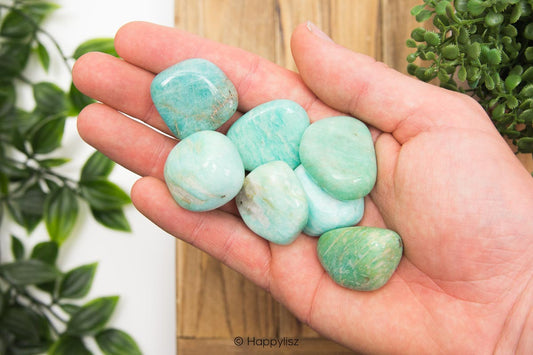Amazonite

Balance • Protection against negative influences • Calming • Free will
Appearance
A green or green-blue stone that ranges from slightly translucent to opaque, with a matte to glassy luster.
Rarity
Moderately rare.
Balance • Protection against negative influences • Calming • Free will
Energetic properties
Amazonite promotes balance and protects against negative energy, as well as electromagnetic radiation and the harmful effects of environmental pollution. You can see this gemstone as a natural filter for such energies. It has a calming effect and brings emotional balance, especially in cases of mood swings, grief, worry, fear, trauma, and sorrow. Amazonite strengthens free will and reduces victim mentality. It also relaxes muscles and has a positive influence on metabolism, the nervous system, and the brain.
Suitable for children from about 6 years old.
Formation
Amazonite is a variety of microcline (KAlSi₃O₈), which belongs to the feldspar group, along with orthoclase, plagioclase, and quartz. It forms through the deposition of these minerals from rising, warm, watery (hydrothermal) solutions that flow through cracks and cavities in rocks. These hydrothermal solutions, rich in dissolved minerals, are the result of geothermal activity and ascending groundwater.
The stone owes its characteristic green color to traces of lead and potassium, while the white streaks or spots are caused by plagioclase.
Amazonite is most commonly found in granitic rocks and pegmatites, which form through the slow cooling and solidification of magma deep beneath the Earth’s crust. Its formation is the result of multiple geological processes occurring over long periods of time.
Etymology
Amazonite is named after the Amazon River in South America, although the stone itself is not actually found in that region. In the 18th century, European explorers believed the green stones they encountered near the Amazon came from the river. It was later discovered that amazonite is primarily found in other regions, including parts of Brazil.
Care
Amazonite should not be exposed to too much water. Although it is water-resistant to some extent, it is a porous mineral that can be sensitive to cracking and scratching. Extended exposure to sunlight is also discouraged, as it may cause the color to fade.
Gentle rinsing under soft running water is possible, but amazonite can also be cleansed and recharged using sage, incense or moonlight.
Because it is porous, amazonite may discolor or become damaged if it comes into contact with harsh chemicals like cleaning agents or perfumes. It's best to avoid wearing the stone while using such substances.
Origin
Australia, Brazil, Colorado, Russia, Virginia (USA), Madagascar & Zimbabwe.
Availability
Amazonite is not particularly rare, but it is also not widely available everywhere. It is mined in several regions around the world, including Russia, the United States, Brazil, Madagascar, and Zimbabwe.
However, its quality and color can vary significantly depending on the location and the conditions in which it was formed. The highest quality amazonite has a bright, vibrant greenish color with white streaks or patches, while lower quality stones may appear dull or darker green.
Some rare varieties, such as crystal-clear amazonite, are harder to find and more expensive than regular amazonite. In general, the stone is not extremely rare, but quality and price can vary depending on the specific variety and origin. It is important to check for authenticity and purchase from a reliable source.
Properties
Composition: SiO₂ / K(AlSi₃O₈)
Hardness: 6-6.5
Density: 2.5-2.6
Associated with Amazonite





-
Amazonite - Postcard
Regular price €2,00Regular priceUnit price / per -
Amazonite - Tumbled Stone
Regular price €4,50Regular priceUnit price / per -
Grief - Crystal Set
Regular price €14,00Regular priceUnit price / per -
Orgonite Disc - Metatron's Cube - Amazonite
Regular price €19,50Regular priceUnit price / per€30,00Sale price €19,50Sale! -
Orgonite Disc - Seed of Life - Amazonite & Blue Chalcedony
Regular price €19,50Regular priceUnit price / per€30,00Sale price €19,50Sale! -
Orgonite Hamsa - Sodalite & Amazonite
Regular price €32,50Regular priceUnit price / per€50,00Sale price €32,50Sale! -
Orgonite Heart - Botswana Agate, Blue Chalcedony & Amazonite
Regular price €22,75Regular priceUnit price / per€35,00Sale price €22,75Sale! -
Orgonite Pyramid - Amazonite & Orange Calcite
Regular price €39,00Regular priceUnit price / per€60,00Sale price €39,00Sale!
















